
Strategy vs. Planning: Unveiling the Key Differences
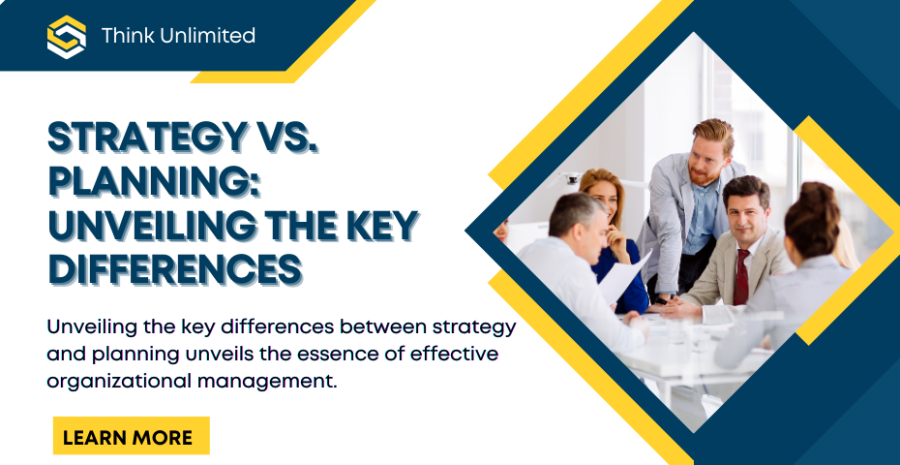
Navigating the terrain of organizational success demands a nuanced understanding of the fundamental concepts that drive progress. At the heart of this quest lies the distinction between strategy and planning, two pillars upon which the edifice of achievement is built. While often used interchangeably, these terms harbor distinct meanings, each bearing unique implications for the trajectory of an enterprise.
Strategy embodies the art of foresight, a visionary blueprint that charts the course towards desired outcomes. It is the compass guiding decisions, aligning actions with overarching goals, and navigating the dynamic currents of change. In contrast, planning is the tactical manifestation of strategy, the meticulous process of delineating the steps required to realize strategic objectives.
Unveiling the key differences between strategy and planning unveils the essence of effective organizational management. Strategy transcends the confines of short-term directives, encompassing a holistic perspective that considers both internal capabilities and external contingencies. Planning, on the other hand, is the pragmatic manifestation of strategy, delineating the sequential actions necessary to actualize strategic intent.
In this exploration, we delve into the intricacies of strategy versus planning, dissecting their respective roles in driving organizational success. Through this journey, we illuminate the symbiotic relationship between these two constructs, unveiling their synergistic potential in shaping the future landscape of business endeavors.
Understanding the disparities between strategy and planning is pivotal for effective organizational management. Strategy encapsulates the overarching vision and direction of an entity, serving as a compass that guides decision-making and resource allocation. It involves assessing internal strengths and weaknesses, as well as external opportunities and threats, to formulate a cohesive roadmap for success. Essentially, strategy delineates the "what" and the "why" behind an organization's actions, setting the stage for long-term sustainability and competitive advantage.
In contrast, planning constitutes the tactical implementation of strategic objectives. It involves breaking down the broader strategic vision into actionable steps, timelines, and responsibilities. Planning addresses the "how" of achieving strategic goals, focusing on the specific tasks and resources required to execute the strategy effectively. While strategy sets the direction, planning provides the detailed road map for reaching the desired destination, ensuring that organizational efforts are coordinated and aligned with strategic intent.
One key distinction between strategy and planning lies in their time horizons. Strategy typically operates on a longer-term basis, encompassing a horizon that spans several years or even decades. It takes into account macroeconomic trends, industry dynamics, and evolving customer preferences to anticipate future opportunities and challenges. In contrast, planning tends to be more short-term in nature, focusing on the immediate actions needed to advance strategic objectives within a defined timeframe.
Moreover, strategy is dynamic and adaptive, capable of evolving in response to changing circumstances and market conditions. It requires continuous monitoring, evaluation, and adjustment to ensure relevance and effectiveness over time. Planning, on the other hand, is more structured and sequential, following a predefined set of steps to achieve predefined outcomes within a specific timeframe.
Another critical distinction lies in the level of abstraction inherent in each concept. Strategy operates at a higher level of abstraction, encompassing broad principles and guidelines that provide a framework for decision-making across the organization. Planning, on the other hand, deals with concrete details and specifics, translating strategic directives into actionable initiatives and projects that can be implemented on the ground.
Furthermore, strategy is a multidimensional concept that encompasses various facets of organizational management, including market positioning, resource allocation, innovation, and risk management. It requires a holistic understanding of the business environment and a nuanced approach to balancing competing priorities and trade-offs. Planning, by contrast, is more narrowly focused on the execution of specific tasks and projects, with a primary emphasis on efficiency and effectiveness.
Additionally, strategy often involves trade-offs and choices that reflect the organization's priorities and values. It requires making difficult decisions about where to allocate scarce resources and how to prioritize competing objectives. Planning, on the other hand, is more operational in nature, focusing on the practical details of implementation rather than the strategic considerations that underpin them.
Moreover, strategy is inherently forward-looking, seeking to anticipate and shape future developments in the marketplace. It involves taking calculated risks and embracing uncertainty in pursuit of long-term success. Planning, by contrast, is backward-looking, drawing on past experience and historical data to inform decision-making and mitigate risk.
Furthermore, strategy requires a high degree of creativity, vision, and strategic thinking. It involves challenging conventional wisdom, exploring new opportunities, and envisioning alternative futures for the organization. Planning, on the other hand, is more analytical and process-driven, relying on established methodologies and best practices to achieve predefined objectives.
In summary, while strategy and planning are closely related concepts, they serve distinct purposes and operate at different levels of abstraction, time horizons, and complexity. Strategy provides the overarching vision and direction for an organization, setting the stage for long-term success and competitive advantage. Planning, on the other hand, focuses on the tactical implementation of strategic objectives, translating broad principles into actionable initiatives and projects. By understanding the key differences between strategy and planning, organizations can better align their efforts and resources to achieve their desired outcomes.
15 key-points to look out for about Strategy vs. Planning: Unveiling the Key Differences
1. Strategic Intent:

Strategy defines the overarching purpose and direction of an organization, whereas planning focuses on the specific actions needed to achieve strategic goals. Strategic intent serves as the guiding force behind organizational decisions, aligning efforts toward a common purpose.It provides a framework for prioritizing initiatives, allocating resources, and evaluating opportunities.
Strategic intent fosters cohesion and alignment across diverse stakeholders, inspiring collective action toward shared goals.It embodies the aspirations and ambitions of the organization, driving innovation and growth.Strategic intent transcends short-term objectives, focusing on sustainable value creation and competitive advantage.It instills clarity and direction, empowering individuals and teams to make decisions that advance the organization's strategic agenda.
2. Long-term vs. Short-term:
Strategy typically operates on a longer-term horizon, spanning several years or even decades, while planning tends to be more short-term, focusing on immediate actions and outcomes. Long-term planning emphasizes sustainable growth and enduring success, while short-term planning focuses on immediate results and operational efficiency.Long-term strategies require patience and resilience, as they often involve investments and changes that may take time to materialize.
Short-term planning is vital for addressing immediate challenges and opportunities, ensuring the organization remains agile and responsive in a dynamic environment.Long-term perspectives enable organizations to anticipate and prepare for future trends and disruptions, while short-term perspectives prioritize quick wins and short-term goals.
Balancing long-term and short-term considerations is essential for strategic agility and resilience, allowing organizations to navigate uncertainty while staying focused on their overarching vision.Effective leaders understand the importance of both long-term and short-term planning, integrating them into a cohesive strategic approach that maximizes value creation over time.
3. Flexibility and Adaptability:

Strategy is dynamic and adaptable, requiring continuous monitoring and adjustment in response to changing circumstances, whereas planning is more structured and sequential. Flexibility allows organizations to pivot and adjust their strategies in response to changing market conditions, emerging trends, and unexpected challenges.Adaptability enables organizations to seize new opportunities and stay ahead of the competition by embracing innovation and experimentation.
Flexible strategies are resilient and responsive, capable of evolving in real-time to meet evolving customer needs and competitive pressures.Adaptive organizations foster a culture of continuous improvement and learning, empowering employees to embrace change and embrace new ways of working.Balancing flexibility with stability is key, as organizations must remain grounded in their core values and strategic direction while remaining open to new possibilities and approaches.Leaders play a crucial role in fostering flexibility and adaptability within their organizations, setting the tone for a culture that embraces change and values agility.
4. Abstraction Level:
Strategy operates at a higher level of abstraction, encompassing broad principles and guidelines, while planning deals with concrete details and specifics. At a higher abstraction level, strategic decisions are guided by overarching principles and long-term objectives, providing a holistic view of the organization's direction.Abstraction allows leaders to communicate complex strategic concepts in a simplified manner, facilitating alignment and understanding across diverse stakeholders.
Strategic decisions made at a higher level of abstraction provide a framework for prioritizing and evaluating tactical initiatives, ensuring they are aligned with broader strategic goals.Conversely, planning operates at a lower level of abstraction, dealing with the concrete details and practicalities of implementation.
While strategy sets the overall direction and purpose of the organization, planning translates strategic objectives into actionable plans and initiatives.Balancing abstraction levels is essential for effective decision-making, as it ensures that strategic intent is translated into practical actions that drive tangible results.
5. Decision-making Framework:
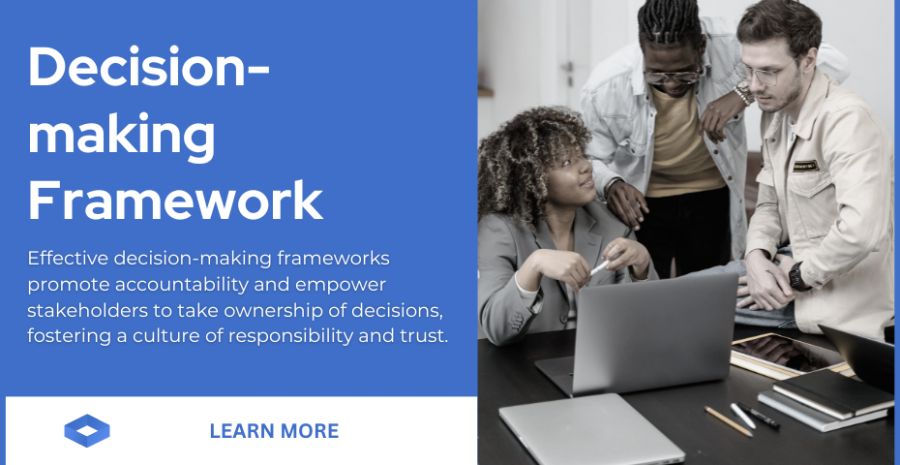
Strategy provides a framework for decision-making across the organization, guiding resource allocation and prioritization, whereas planning focuses on the practical details of implementation. A robust decision-making framework integrates strategic considerations, data-driven insights, and stakeholder perspectives to facilitate informed and effective decision-making.
Decision-making frameworks provide a structured approach to evaluating options, assessing risks, and weighing trade-offs in alignment with strategic objectives.By establishing clear criteria and decision-making processes, frameworks help organizations make consistent and transparent decisions across different contexts and scenarios.Effective decision-making frameworks promote accountability and empower stakeholders to take ownership of decisions, fostering a culture of responsibility and trust.
Leaders play a crucial role in championing and implementing decision-making frameworks, ensuring they are aligned with the organization's values and strategic priorities.Continuously refining and adapting decision-making frameworks enables organizations to remain agile and responsive in a dynamic and uncertain environment.
6. Forward-looking vs. Backward-looking:
Strategy is forward-looking, seeking to anticipate and shape future developments in the marketplace, while planning draws on past experience and historical data to inform decision-making. Forward-looking strategies anticipate future trends and opportunities, enabling organizations to proactively shape their destiny rather than merely reacting to events.
Backward-looking analysis draws insights from past experiences and historical data to inform decision-making and mitigate risks, providing valuable lessons learned and benchmarks for performance.While forward-looking approaches embrace uncertainty and innovation, backward-looking perspectives offer a sense of stability and continuity by grounding decisions in proven practices and historical trends.Balancing forward-looking and backward-looking perspectives is essential for strategic agility, as it allows organizations to learn from the past while adapting to changing circumstances and emerging opportunities.
Effective leaders leverage both forward-looking and backward-looking analyses to inform their strategic decisions, integrating insights from past experiences with a vision for the future.Cultivating a culture of continuous learning and adaptation enables organizations to strike the right balance between forward-looking innovation and backward-looking stability, driving long-term success and resilience.
7. Creativity and Innovation:

Strategy requires a high degree of creativity, vision, and strategic thinking, involving exploration of new opportunities and alternative futures, whereas planning is more analytical and process-driven. Creativity fuels innovation by encouraging novel approaches, out-of-the-box thinking, and imaginative problem-solving that challenge the status quo. Innovation harnesses creative ideas and transforms them into tangible solutions, products, or processes that add value and drive growth.
Cultivating a culture of creativity and innovation fosters a dynamic environment where employees are empowered to explore new possibilities and take calculated risks.Effective leaders champion creativity and innovation by providing the resources, support, and encouragement needed to unleash the creative potential of their teams.Embracing failure as a natural part of the innovation process encourages experimentation and learning, fostering a culture where setbacks are viewed as opportunities for growth.
Balancing creativity and innovation with operational efficiency and risk management is essential for sustainable success, as it ensures that creative ideas are translated into tangible results that align with strategic objectives.
8. Risk Management:
Strategy involves taking calculated risks and embracing uncertainty in pursuit of long-term success, while planning focuses on mitigating risks and ensuring operational efficiency. Effective risk management involves identifying, assessing, and mitigating potential threats and opportunities that may impact the achievement of strategic objectives.It requires a proactive approach to anticipate and manage risks, rather than reacting to them after they have materialized.
Risk management encompasses a wide range of activities, including risk identification, analysis, prioritization, and response planning.Balancing risk and reward is essential for making informed decisions that maximize value while minimizing exposure to potential harm.
Strong risk management practices instill confidence among stakeholders and enhance organizational resilience by enabling the organization to adapt to changing circumstances and unforeseen challenges.Leadership commitment and accountability are critical for fostering a risk-aware culture where risk management is integrated into strategic planning and decision-making processes.
9. Organizational Scope:

Strategy encompasses various facets of organizational management, including market positioning, resource allocation, innovation, and risk management, whereas planning is more narrowly focused on specific tasks and projects. The organizational scope of strategy encompasses various dimensions, including market positioning, product development, operational efficiency, and talent management.
Strategy defines the boundaries within which the organization operates and sets the parameters for decision-making at all levels.It involves aligning organizational capabilities with external opportunities to create sustainable value for stakeholders.Planning, on the other hand, focuses on specific projects, initiatives, and activities within the broader scope defined by strategy.
Effective coordination and integration across different functions and departments are essential for ensuring alignment with strategic objectives and maximizing organizational effectiveness.A clear understanding of organizational scope enables leaders to identify areas of strength and opportunities for improvement, guiding resource allocation and investment decisions.
10. Trade-offs and Choices:
Strategy often involves making trade-offs and choices that reflect the organization's priorities and values, whereas planning emphasizes efficiency and effectiveness in execution. Making trade-offs involves prioritizing certain objectives or actions over others, recognizing that resources are finite and decisions have consequences.Effective leaders understand the importance of making strategic trade-offs to optimize resource allocation and maximize value creation.
Trade-offs require careful consideration of competing priorities, weighing the potential benefits and drawbacks of each option.Embracing trade-offs fosters strategic clarity and focus, enabling organizations to allocate resources in alignment with their most important goals.
By making conscious choices about where to invest time, money, and effort, organizations can enhance their competitive advantage and achieve sustainable growth.Transparency and communication about trade-offs are essential for ensuring alignment and buy-in across the organization, fostering a culture of accountability and collaboration.
11. Continuous Evaluation and Adjustment:
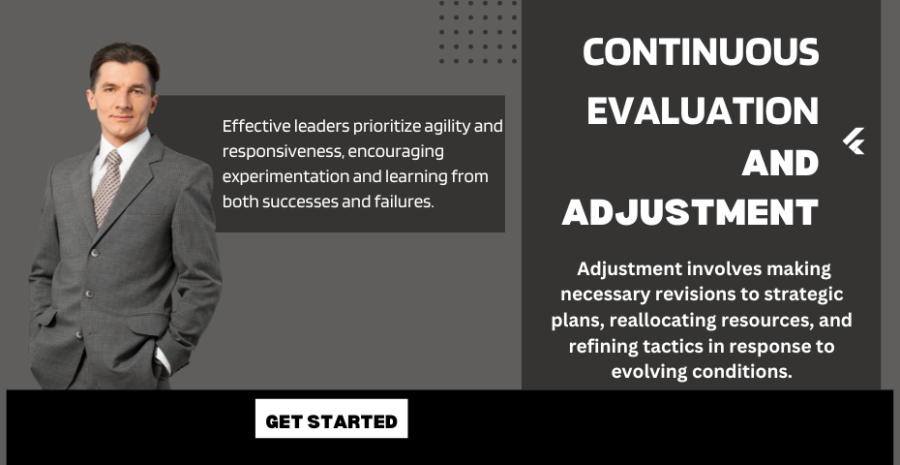
Strategy requires continuous monitoring, evaluation, and adjustment to ensure relevance and effectiveness over time, whereas planning follows a predefined set of steps and timelines. Continuous evaluation involves regularly monitoring performance metrics, market trends, and external factors to assess the effectiveness of strategic initiatives.
It requires a systematic approach to collecting and analyzing data, identifying areas for improvement, and making informed decisions based on real-time insights. By embracing a culture of continuous evaluation, organizations can adapt quickly to changing circumstances and seize emerging opportunities. Adjustment involves making necessary revisions to strategic plans, reallocating resources, and refining tactics in response to evolving conditions.
Effective leaders prioritize agility and responsiveness, encouraging experimentation and learning from both successes and failures.Continuous evaluation and adjustment enable organizations to stay ahead of the curve, maintaining relevance and driving sustainable growth in a dynamic environment.
12. Role of Creativity and Vision:
Strategy relies on creativity and vision to challenge conventional wisdom and envision alternative futures for the organization, whereas planning follows established methodologies and best practices. Creativity fuels innovation by encouraging fresh perspectives, unconventional thinking, and the exploration of new possibilities. Vision provides a clear and compelling direction, inspiring employees to work towards a common purpose and transcend current limitations.
Together, creativity and vision empower organizations to anticipate market trends, identify untapped opportunities, and differentiate themselves from competitors. Leaders who foster a culture of creativity and vision cultivate an environment where employees feel empowered to take risks, experiment with new ideas, and challenge the status quo.
Creativity and vision are essential for driving organizational growth and resilience in a rapidly changing business landscape. By nurturing creativity and articulating a compelling vision, leaders can inspire passion, commitment, and innovation throughout the organization, unlocking its full potential.
13. Role in Organizational Culture:
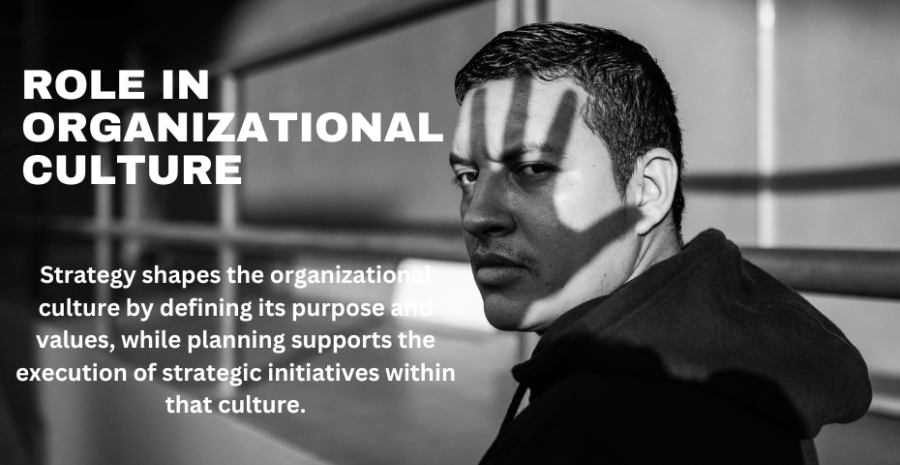
Strategy shapes the organizational culture by defining its purpose and values, while planning supports the execution of strategic initiatives within that culture. The role of strategy and planning in organizational culture extends beyond mere execution; it shapes values, norms, and behaviors.
An organization's strategic priorities and planning processes influence how decisions are made, how resources are allocated, and how success is defined. A culture that values strategic thinking and effective planning fosters alignment, accountability, and adaptability throughout the organization. Conversely, a culture that neglects strategy and planning may struggle with inconsistency, inefficiency, and a lack of direction.
Leaders play a pivotal role in shaping organizational culture by modeling strategic behaviors, promoting transparency, and reinforcing the importance of planning. By integrating strategy and planning into the fabric of organizational culture, leaders can create a dynamic and resilient environment that drives sustainable success.
14. External Focus:
Strategy has an external focus, considering market dynamics, competitor actions, and customer needs, whereas planning has an internal focus, dealing with resource allocation and operational processes. An external focus ensures that organizations remain attuned to evolving market dynamics, customer needs, and competitor actions. It involves gathering intelligence, analyzing trends, and anticipating changes in the external environment to inform strategic decision-making.
Organizations with a strong external focus are proactive in identifying opportunities and threats, enabling them to capitalize on emerging trends and mitigate risks. By prioritizing external factors, organizations can align their strategies and plans with market demands, enhancing their competitive position and long-term viability.
Effective leaders foster an external focus by encouraging curiosity, collaboration, and a customer-centric mindset throughout the organization. Cultivating an external focus enables organizations to stay agile, responsive, and resilient in the face of uncertainty and disruption.
15. Leadership Involvement:
Strategy requires strong leadership involvement in setting the vision and direction of the organization, while planning involves coordination and collaboration across different departments and teams. Leadership involvement is critical for ensuring that strategy and planning initiatives are aligned with the organization's vision and values. Effective leaders provide guidance, direction, and support to ensure that strategic objectives are clearly communicated and understood throughout the organization.
They champion strategic thinking and effective planning, empowering teams to take ownership of their roles in executing the organization's vision. Leadership involvement fosters accountability and collaboration, creating a culture of shared responsibility and commitment to achieving strategic goals.
By actively engaging in strategy and planning processes, leaders demonstrate their commitment to organizational success and inspire confidence among stakeholders. Leadership involvement also ensures that strategic decisions are made with a deep understanding of the organization's capabilities, market dynamics, and competitive landscape.
In conclusion.
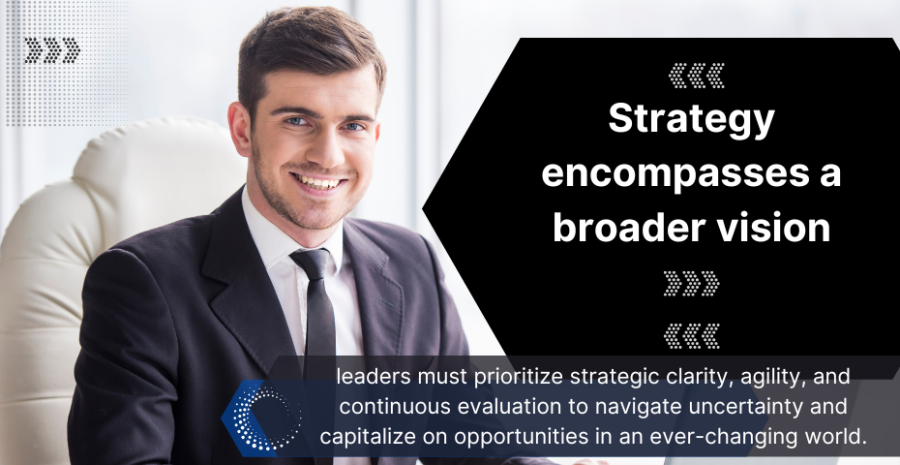
While planning is an indispensable component of organizational success, it alone does not constitute a comprehensive strategy. Strategy encompasses a broader vision, guiding the direction and purpose of an organization, while planning focuses on the tactical execution of strategic objectives. Understanding the distinction between strategy and planning is essential for leaders to effectively navigate the complexities of today's business landscape.
By embracing strategic thinking and integrating planning into a cohesive strategic framework, organizations can unlock their full potential and achieve sustainable growth. It is the fusion of strategic vision, creativity, adaptability, and leadership involvement that propels organizations forward, not merely the execution of detailed plans. Therefore, leaders must prioritize strategic clarity, agility, and continuous evaluation to navigate uncertainty and capitalize on opportunities in an ever-changing world.
Remember, while planning is crucial, it is the strategic vision that ultimately charts the course toward long-term success.
(17).jpg)
About: Andries vanTonder
Over 40 years selfemployed
He is a Serial Entrepreneur, an Enthusiastic supporter of Blockchain Technology and a Cryptocurrency Investor
Find me: Markethive Profile Page | My Twitter Account | My Instagram Acount | and my Facebook Profile.
